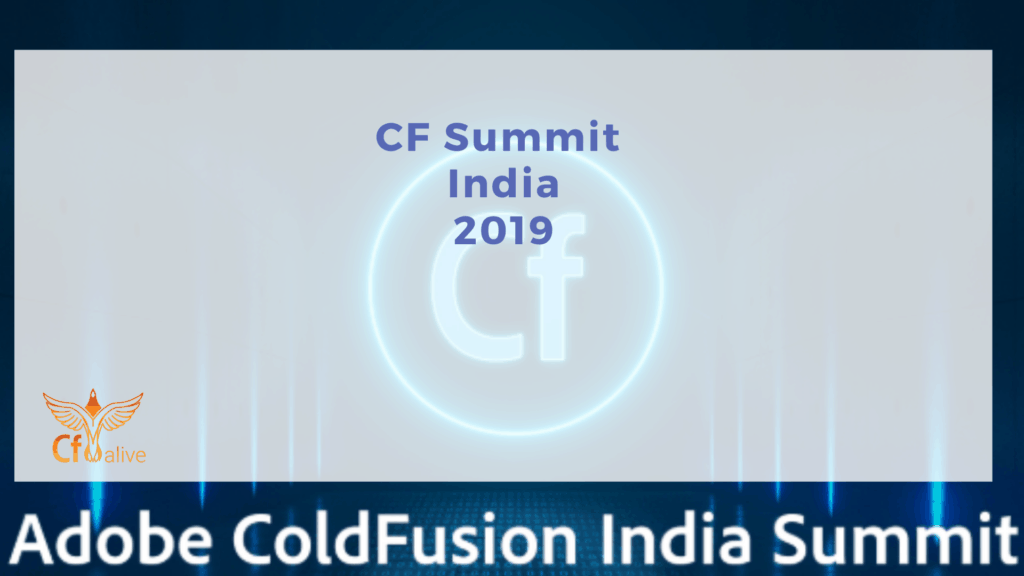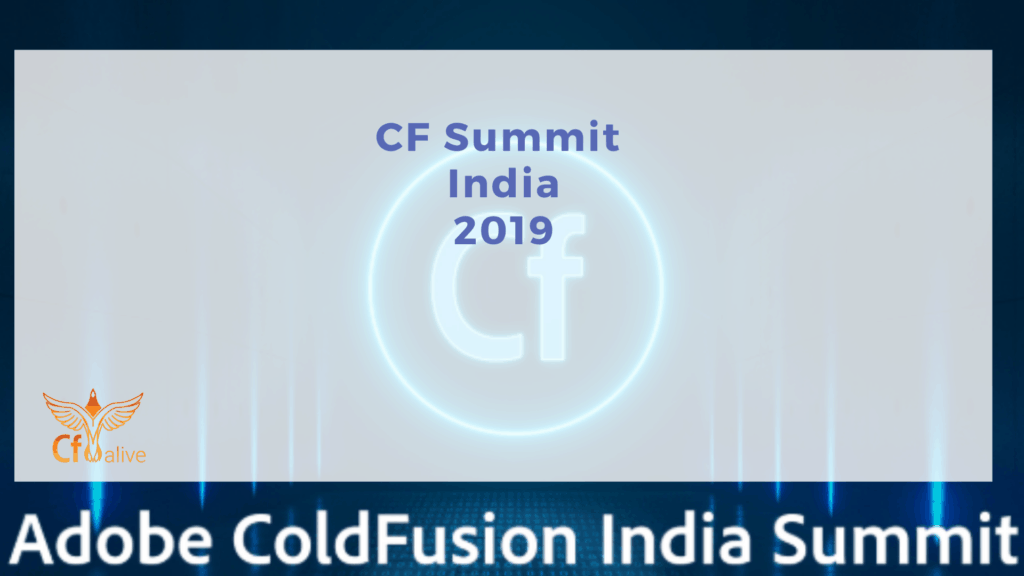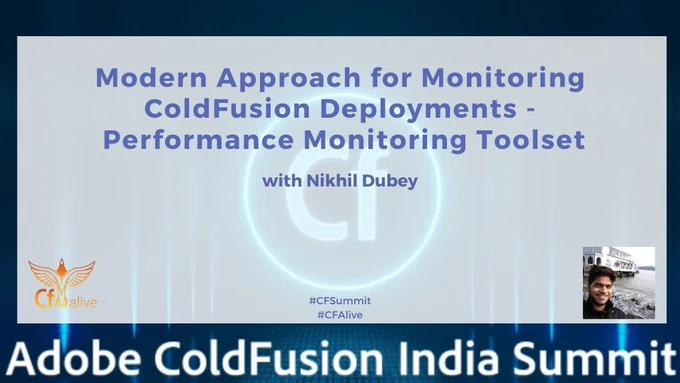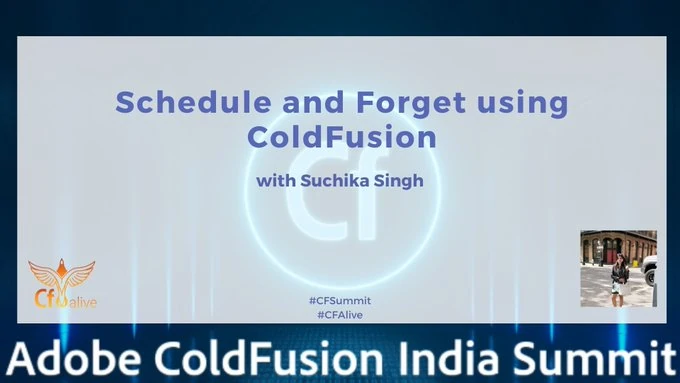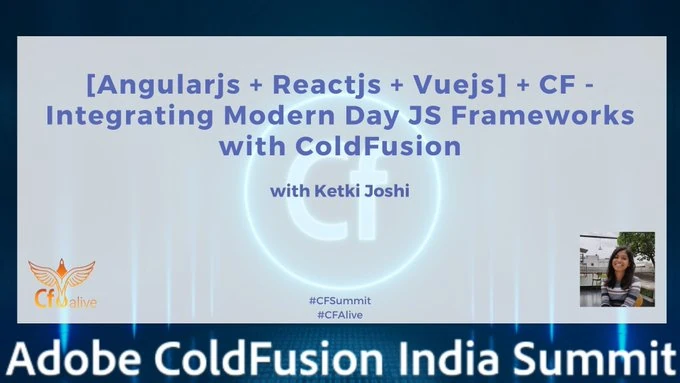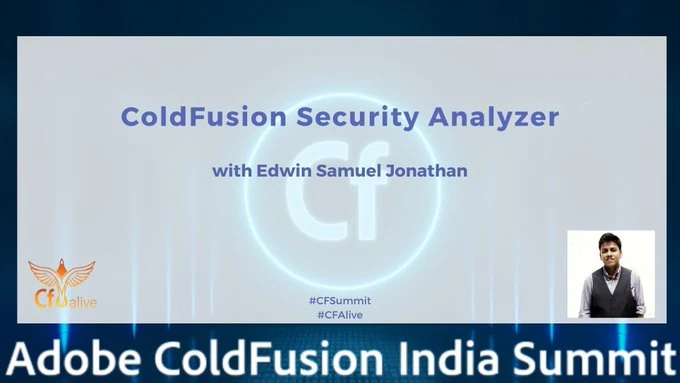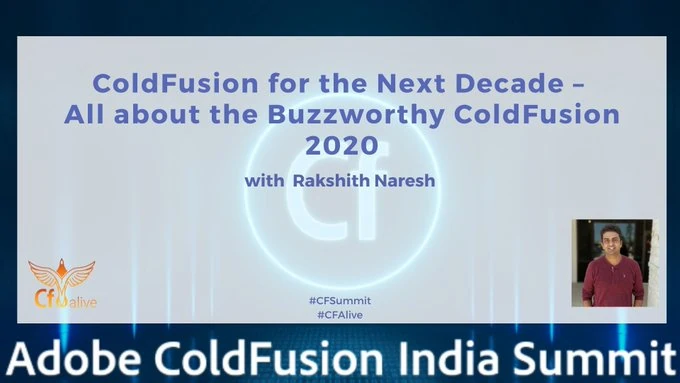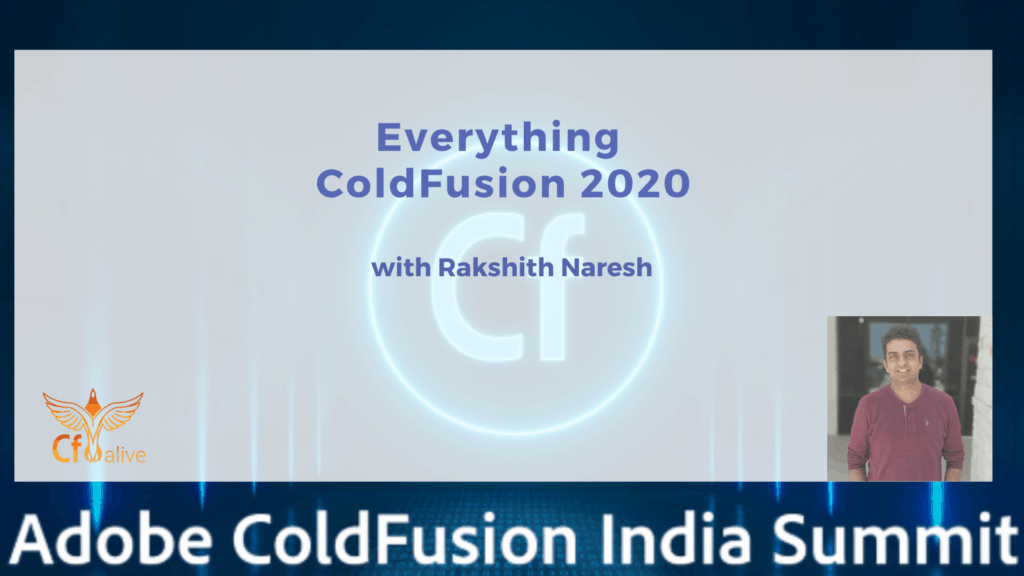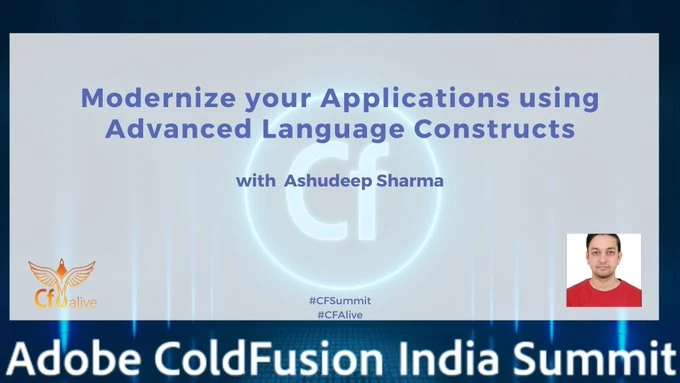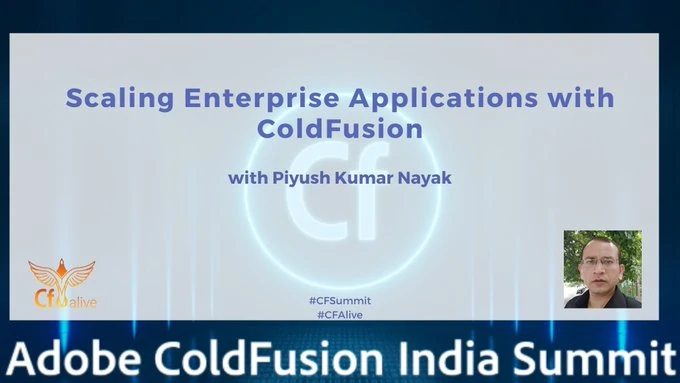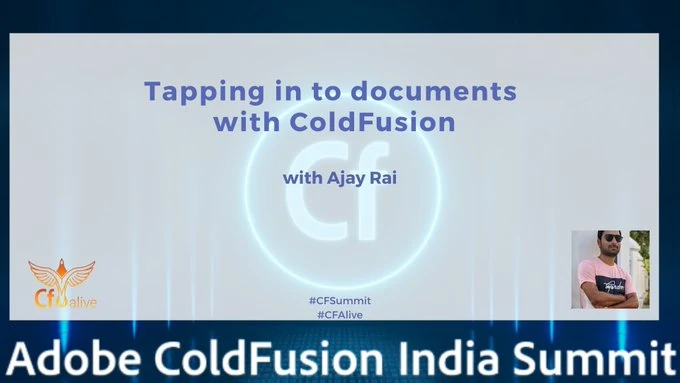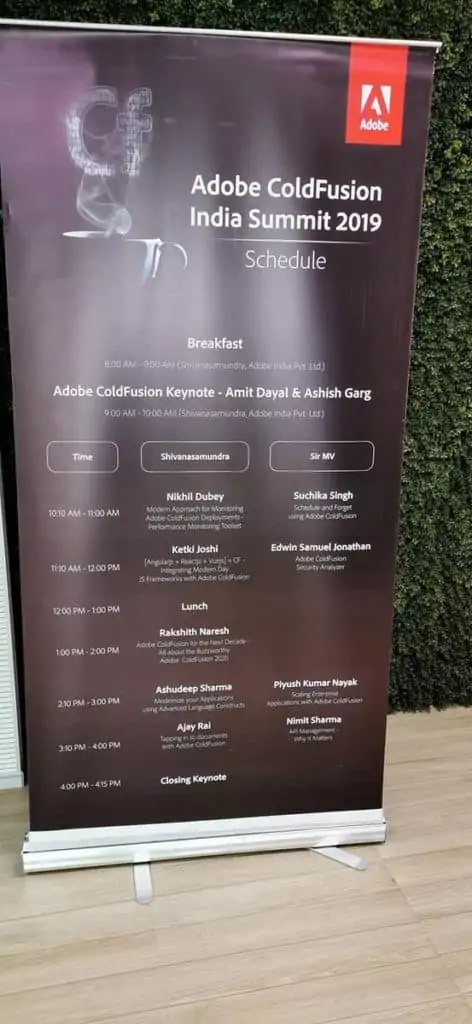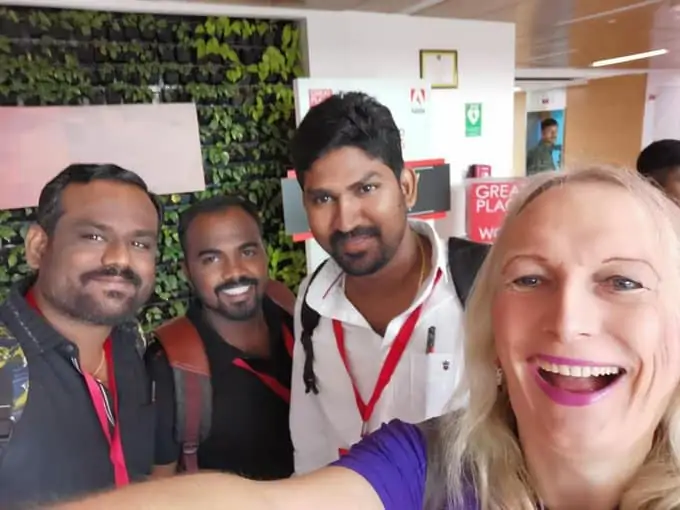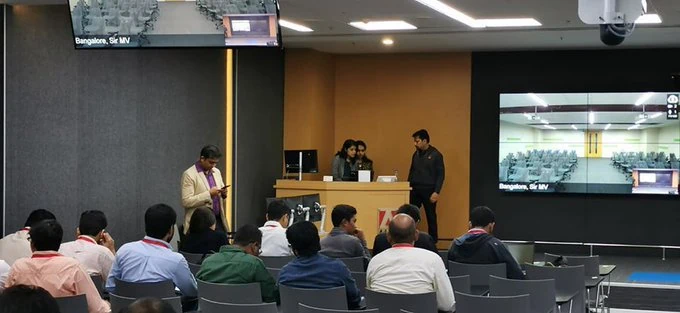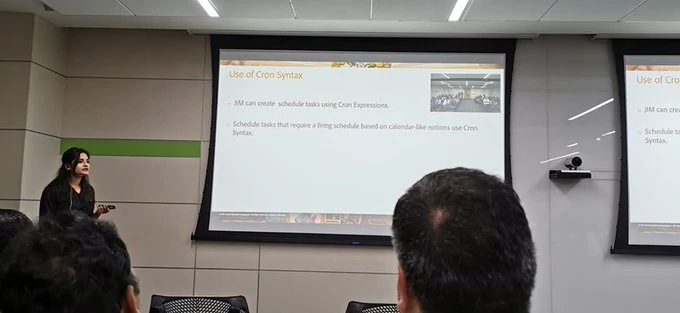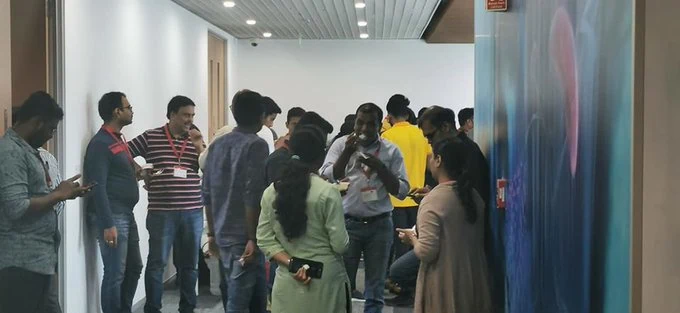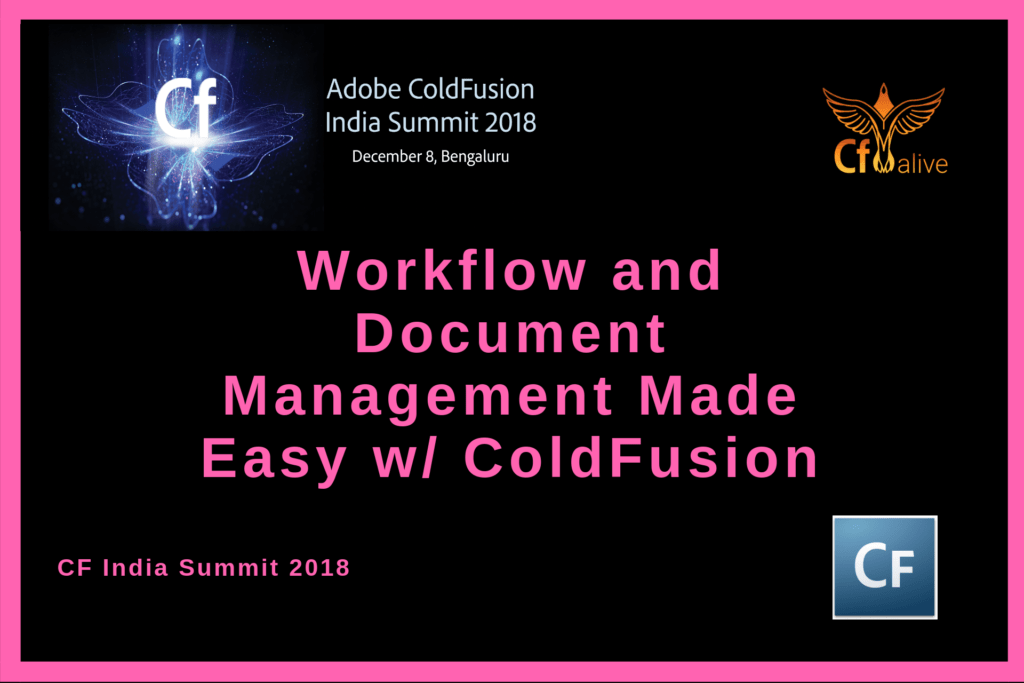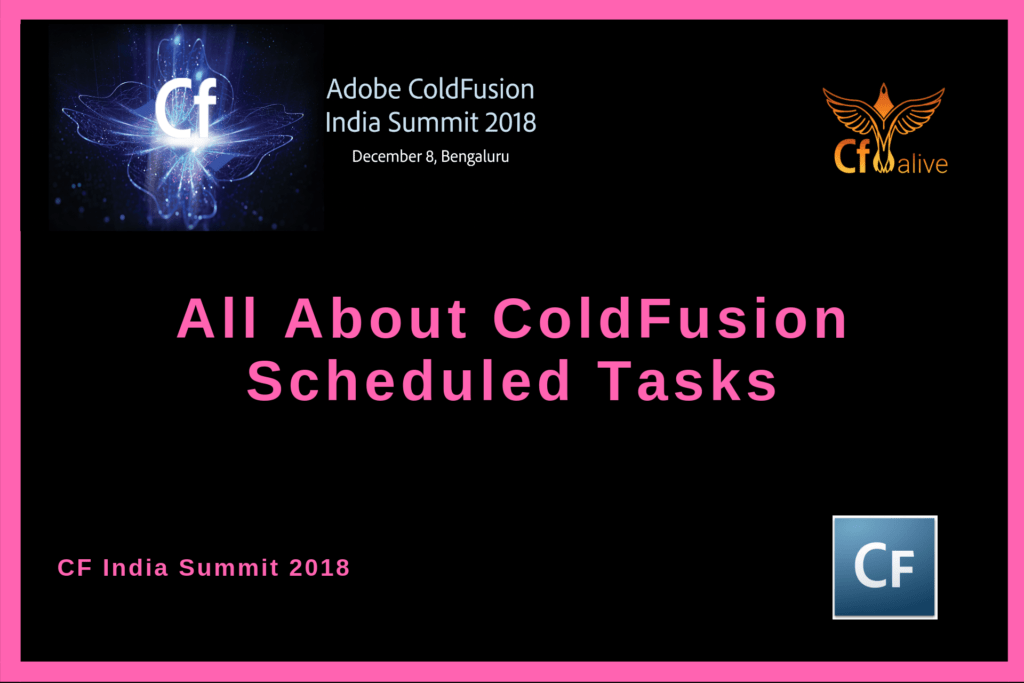Join us for a complimentary one-day event filled with expert insights, live-streamed sessions, networking opportunities, and exciting prizes. Whether you’re in Noida or Bengaluru, this is your chance to advance your web development skills with industry experts.
🔗Register for FREE Today: https://cf-indiasummit-2024.attendease.com/
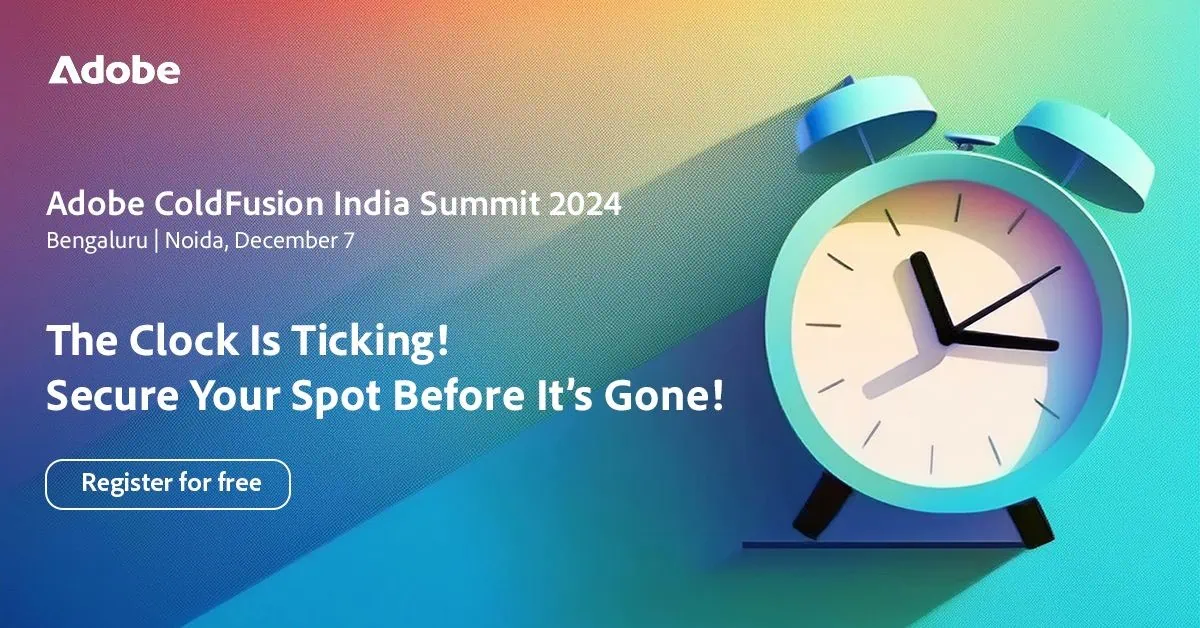
Contents
- Adobe CF Summit India (Comprehensive Report)
- The key takeaways and learning points
- Adobe ColdFusion Keynote
- Modern Approach for Monitoring ColdFusion Deployments – Performance Monitoring Toolset
- Schedule and Forget using ColdFusion
- [Angularjs + Reactjs + Vuejs] + CF – Integrating Modern Day JS Frameworks with ColdFusion
- ColdFusion Security Analyzer by Edwin Samuel Jonathan
- ColdFusion for the Next Decade – All about the Buzzworthy ColdFusion 2020
- Modernize your Applications using Advanced Language Constructs
- Scaling Enterprise Applications with ColdFusion
- API Management – Why it Matters
- Tapping in to documents with ColdFusion
- CF Summit India 2019 in Pictures
- CF India Summit: Part One – Workflow and Document Management Made Easy w/ ColdFusion
- CF India Summit: Part Two- Keeping Up to Date With Modernized ColdFusion
- CF India Summit Part Three: All About ColdFusion Scheduled Tasks
- CF Tech Talk
- Using the ColdFusion Administrator
- Using the cfschedule Tag
- Grouping Tasks Together
- Running Scheduler in Clusters
- Cron Expressions
- Integration using Quartz Properties
- What’s New in ColdFusion 2018?
- What You Need to Know as CIO
- Pros and Cons of CF Automation
- Future-proofing your Business
- Implementing Automation and Scheduled Tasks
When is it?
- December 7, 2024
Where is it?
- Bengaluru – Adobe Systems
Prestige Platina Technology Park
Building 1, Block A
Marathahalli-Sarjapur Outer
Ring Rd
Kadubeesanahalli
Bengaluru, India 560103 - Noida-Adobe Systems
Plot No.05
Block A-Sector 132
Noida , UP
India 201304
Costs
- No Fee
For whom is this event?
This event is ideal for existing Adobe ColdFusion users who have basic proficiency in the application and are looking to expand their expertise and learn about the upcoming developments and advancements within Adobe ColdFusion. New developers getting started with Adobe ColdFusion would also find the event helpful and insightful. Others are welcome.
Agenda
Title:
Keynote
Speaker:
Vivek Kumar and Charvi Dhoot
Title:
Enhancements in CF Charts & Spreadsheets
Speaker:
Yukti Agrawal
Description:
In this session, we’ll dive into the latest innovations in ColdFusion’s charting and spreadsheet functionalities, designed to streamline data management and visualization for developers. Discover how these enhanced features make it easier than ever to create engaging, data-rich applications that bring value to end-users. We’ll cover new chart types and customization options such as rules, animation, themes and many more that allow for more interactive, visually compelling graphics, as well as spreadsheet improvements like sheet management, print formatting, data validation, row column grouping and csv processing operations . Ideal for developers currently using or want to take advantage of these features in future.
Title:
From Spaghetti to Modern Frameworks: A Journey Through ColdFusion Application Architecture
Speaker:
Kai Koenig
Description:
I've been working with CFML for the better part of 25 years now. Over this time, we've come a long way in how applications in ColdFusion are being written. This is a somewhat lighthearted, yet technically insightful trip down memory lane as we explore the evolution of ColdFusion application architectures and frameworks. This talk will cover the progression from early and really basic structural patterns to modern, sophisticated frameworks, highlighting how ColdFusion development practices have matured over the years. Key Points: 1. Early days: Spaghetti code and the need for structure 2. Home-grown frameworks: Includes, Custom Tags, CFCs and basic Model-View-Controller 3. The rise of Fusebox: Introducing circuit and fuseaction concepts 4. Mach-II: Moving towards object-oriented design 5. FW/1: Lightweight alternative for rapid development 6. ColdBox: Full-stack HMVC framework revolution 7. Modern ColdFusion: Current best practices and architectural patterns Throughout the presentation, we'll showcase code examples demonstrating the different styles and approaches of each era, sprinkled with some humorous anecdotes about the challenges developers faced. We'll also discuss how these changes reflect broader trends in web development and how ColdFusion has changed to meet evolving industry needs. This talk will provide valuable historical context for both seasoned ColdFusion developers and newcomers to the platform, offering insights into why certain patterns emerged and how they've shaped current best practices in ColdFusion application development.
Title:
ColdFusion and Generative AI
Speaker:
Nikhil Dubey
Description:
Explore the intersection of ColdFusion and Generative AI, where modern web application development meets cutting-edge AI capabilities. This session will dive into how ColdFusion developers can leverage generative AI tools to enhance automation, improve user experiences, and streamline complex workflows. Discover practical integrations and innovative applications, equipping you to bring AI-powered creativity into your ColdFusion projects. Join us to see how these powerful technologies combine to elevate development possibilities!
Title:
HTMX
Speaker:
Saravana Muthu
Description:
Learn the 2nd ranked “Front-end Framework” in the “2023 JavaScript Rising Stars” survey. Learn HTMX & modernize your ColdFusion application without rewriting it
Title:
Effortless ColdFusion Migration: A Step-by-Step Guide to Upgrading Your Applications!
Speakers:
Vikram Kumar and Priyank Shrivastava
Description:
Discover the best practices for a seamless ColdFusion migration! In this session, we'll cover key strategies for preparing, planning, and executing your upgrade to ensure a smooth transition, whether you're a developer or an administrator. Gain valuable insights into modernizing your ColdFusion applications with minimal disruption. Join us to learn how to future-proof your apps and take them to the next level—hassle-free!
Title:
Microsoft Graph Integration in ColdFusion: Unlocking data with CFOauth.
Speakers:
Shiva Marella
Description:
Microsoft 365 is a comprehensive cloud-based suite offering productivity and collaboration tools, including popular applications like Word, Excel, PowerPoint, Teams, and Outlook, along with services such as Exchange, SharePoint, and OneDrive. This session will explore the latest advancements in ColdFusion for accessing Microsoft Graph services, with a focus on Microsoft 365 integration.
Attendees will learn how to leverage ColdFusion’s built-in CFOAuth framework to handle authentication and authorization for both enterprise applications and individual users, enabling secure interactions with Microsoft Graph and access to the extensive data within Microsoft 365. We will also cover native integrations with Microsoft 365 services, such as Exchange Online using cfexchange tags, and dive into the new Microsoft Entra user management features. The session will showcase how ColdFusion’s built-in functions simplify data access, creating seamless connections with Microsoft’s powerful cloud-based ecosystem.
Title:
Cf security best practises and options
Speakers:
Satyam Mishra
Description:
To ensure ColdFusion servers are secure, it's essential to follow best practices and leverage ColdFusion's built-in security options.
Enhance knowledge on Adobe's latest security patches, understanding how critical these updates are and which vulnerabilities they address. Recognize why code-breaking changes may be necessary to enhance protection.
How ColdFusion developers can further strengthen security by implementing best practices within their application code. Know more about industry & network best practises.
Know more about how Adobe is dedicated to maintaining a robust and secure ColdFusion environment, ensuring protection at both the server and application levels.
Title:
Exploring the Smart Language Additions in ColdFusion Markup Language
Speakers:
Ashudeep Sharma
Description:
We have been using ColdFusion Markup Language all along since three decades. With the release of ColdFusion 2021, we pitched in the theme of making CFML as ECMAScript Compliant and added functionalities like Destructuring/Spread Operator/Rest Operator and many more.
These functionalities are quite powerful and go all along with the theme of Do More with Less Code. There have been significant improvements as well as new additions which i would like to cover in the session. This would provide valuable insights to our fellow developers as to how to use these functionalities by writing just few lines of code.
This in turn will pave a way for our fellow developers who are used to writing more LOC to do some complex processing.
In this sessions, I would like to cover all the significant additions that have been done for the coming ColdFusion Release as well as in past few releases, which are powerful enough but are not used as such because only few developers knows how to use them.
Title:
All-in-One ColdFusion Development with the Adobe ColdFusion extension for VS Code: A Modern Developer's Toolkit
Speakers:
Vikas Yadav
Description:
Learn how to elevate your ColdFusion development with the Adobe ColdFusion Builder extension for VS Code, bringing advanced editing capabilities, debugging, and coding insights directly into your editor. This session introduces everything you need to work faster and smarter with ColdFusion in VS Code.
Title:
Htmltopdf: A one stop shop for all your document needs!
Speakers:
Kaushik L V
Description:
ColdFusion’s htmltopdf feature takes document creation to the next level! Imagine turning any HTML content – whether it’s a report, an invoice, or a beautifully styled form – into polished, interactive PDFs with just a few lines of code. You get full control over styling, with CSS for branding and JavaScript for dynamic elements, so every PDF looks fantastic and fits your exact needs. Add headers, footers, page numbers, and watermarks to keep it professional, and customize page size and orientation for any format. Plus, with seamless workflow automation, htmltopdf makes it easier than ever to generate high-quality PDFs on demand, saving time and impressing users!
Title:
Closing keynote
Speakers:
Kishore Balakrishnan
Speakers
Yukti Agrawal
Member of technical Staff II
Kishore Balakrishnan
Director, Marketing
Charvi Dhoot
Sr. Product Manager
Nikhil Dubey
Computer Scientist II
A seasoned developer with over nine years of experience, I am currently part of Adobe’s ColdFusion engineering team, where I help shape and evolve the CFML language. I am deeply engaged in refining and enhancing the ColdFusion platform, from optimizing its core functionality to innovating with new language features like GraphQL, IIFEs, parallel programming, dynamic switch-case that meet the demands of modern web development. I also worked in building PMT and VSCode extension for ColdFusion. My focus lies in delivering robust performance, security, and ease of use, empowering developers worldwide to build efficient, scalable applications. Beyond coding, I enjoy collaborating with a diverse team of skilled professionals, constantly learning and adapting to the latest industry trends.
Kai Koenig
Self Employed
Kai is one of the co-founders of and works as Software Architect for Ventego Creative Ltd in Wellington, New Zealand.
Kai got his first computer in 1985 and hasn’t stopped building things with technology since then.
As a software architect he works with a variety of clients to help them leverage technology to achieve their business visions and goals. He specialises in JVM-based technologies (like ColdFusion/CFML, Java, Kotlin, Clojure and others) and mobile application development with Android and Flutter as well as leveraging other tech stacks like Python and Ruby as required.
Other areas of Kai’s interest are delivering education online, improving development teams’ performance through continuous integration and build processes as well as data science and machine learning technologies. Kai has a master's degree in Mathematics and Computer Science, and is currently pursuing a master’s degree in Data Science. His mission is to create and deliver high-quality software solutions that solve real-world problems and add value to users and the industry.
Kai has been speaking regularly at international conferences like Droidcon, Mobile Refresh Wellington, CF Camp in Germany, Android Makers in France and many others.
Vikram Kumar
Lead, Product Consultant
Vikram Kumar is a seasoned product consultant and Team Leader in Adobe ColdFusion support with 9 years of specialized experience. He has played a pivotal role in building and optimizing web applications, providing expertise in requirements analysis, technical architecture, and ColdFusion implementation. As a Team Leader, he guides his team and clients through complex challenges, ensuring the delivery of high-performing solutions.
Vivek Kumar
Sr. Director of Products
Kaushik L V
MTS II
Kaushik L V, I am working in ColdFusion from the last 5 years.
During these years I have worked on various features like Htmltopdf, Hibernate, MongoDB and connector.
Shiva Marella
Member of technical Staff II
I am a software developer on Adobe's ColdFusion team for the past 3.5 years, where I’ve contributed significantly to key projects like the GCP Firestore, CFOAuth, and Microsoft Graph extensions, enhancing ColdFusion’s capabilities for cloud and enterprise applications. Outside of work, I enjoy playing sports and video games.
Satyam Mishra
Computer Scientist II
I am Satyam Mishra, a Computer Scientist at Adobe with 10 years of experience in enterprise application development. For the past 5 years, I’ve been part of the ColdFusion team, where I serve as the Security Champion. My work has focused on critical areas such as security, server performance, and the Performance Monitoring Tool for ColdFusion.
Saravana Muthu
Founder, CTO
Ashudeep Sharma
Senior Computer Scientist
I am Ashudeep Sharma, I did my Schooling from Mathura and then pursued my Graduation in Computer Science from Indian Institute of Technology, Banaras Hindu University, Varanasi.
I have around 13 years of Professional experience and during this tenure worked on Distributed Systems, Search, Query Engines, Data stores, Compilers and Application Development.
I have an interest in exploring new design methodologies and Technologies as well as contributing back to the society.
I am working with the ColdFusion team in Adobe as Senior Computer Scientist and before that have worked with Flipkart, Microsoft and Oracle.
I started my Journey with ColdFusion team working on ORM and then got opportunities to work on many things like CFQuery, Advanced Language Constructs, Databases as well as GraphQL
During my free time I enjoy playing sports(Cricket/Baddy/Volley etc),working out, sometimes listening to light music, and reading posts/experiences on Quora.
Priyank Shrivastava
Mgr, Technical Support
Priyank Shrivastava is an experienced Manager at Adobe with over 13 years of expertise in leading support teams for ColdFusion and Adobe Learning Manager. Over the years, he has collaborated with ColdFusion customers worldwide, resolving a wide variety of issues and enhancing customer experiences. Priyank is an active contributor to the ColdFusion community, sharing insights and solutions across platforms like Adobe Community, CF Blogs, and CFML Slack.
Vikas Yadav
Computer Scientist II
Vikas is working as Computer Scientist at Adobe and has more than 10 years of experience in field of Software Development. He has worked on various features in ColdFusion, including compiler, Language Features, Performance, and VS Code extension.
Adobe CF Summit India (Comprehensive Report)
I had the pleasure of attending this conference organized by Adobe ColdFusion team, in the first week of December.
After the CF Summit West 2019 in Las Vegas which is the biggest ColdFusion conference in the world, which was in October, this event took place in Bengaluru.
It is a confluence of everything in the realm of web applications. If you develop web applications, this is the place to be. For designers, developers, strategists and thought leaders, the ColdFusion India Summit provides the perfect forum to exchange ideas, inspiration, and experiences.
In addition to opportunities to interact with ColdFusion experts, domain leaders and peers, get to learn about the latest technologies, techniques, and strategies to rapidly build and successfully deliver web applications to the market. With the web applications scenario evolving rapidly, explore how ColdFusion is driving change and how you can propel this dynamism.
Registration was complimentary.
The key takeaways and learning points
- ColdFusion Roadmap and New Features coming in Next Release
- Top ColdFusion Features and Benefits
- API Development and Management
- Performance Tuning and Management
- PDF Manipulation and Advanced Security
The morning was very interesting. To see so many interesting people (again) and meet new was such an honor.
Registration and we’re ready to start the show!
Adobe ColdFusion Keynote
Amit Dayal and Ashish Garg talked about a general CF stuff, but also gave us a heads up on the roadmap and what’s on Adobe’s sight for the next year.
We hear that we can expect ColdFusion 2020 alpha release soon.
Amit Dayal
Passionate about great products, new ideas, and technology excellence. Love bringing together engineers, scientists, designers, and product managers to build products that can help millions of users. Enjoy wearing multiple hats. Worked for many years in Silicon Valley, at both startups and large tech companies. Have now almost a decade of experience in Bangalore. In a past life, did serious hands-on work on parallel Unix kernels.
Ashish Garg
Ashish is Director of Engineering at Adobe Inc., Bangalore. Ashish leads the engineering teams for Adobe ColdFusion and eLearning products portfolio from Adobe, that includes Adobe Captivate, Adobe Captivate Prime and Adobe Connect. Ashish is associated with Adobe for close to 15 years and in this tenure, has worked on a numerous products and idea projects. Ashish has experience with a wide set of technologies and platforms ranging from desktop, mobile, server to cloud. Ashish is very interested in fostering innovation and is passionate about usage of technology in solving any type of problem. He likes to follow the technology trends and evolve products along with them. Apart from programming languages, he is a keen AI/ML enthusiast. Ashish loves sports, music and reading. Ashish holds a Masters in Computers Applications from Panjab University, Chandigarh.
Modern Approach for Monitoring ColdFusion Deployments – Performance Monitoring Toolset
The first talk after the keynote was by Nikhil Dubey and here are the key points:
- What are the monitoring requirements of any online applications?
- Overview of architecture of PMT
- Use cases and corresponding features with Demo –
- Node Down Scenario
- Black Friday – Sudden spike in Traffic
- Auto-Connector tuning
- Features without demo –
- Ease of Use & Navigation
- Memory Leaks
- Threads
- Caching
- Active Monitoring
- Alerts
- Archiving Strategy
Takeaways
- For developers, they get to know about important scenarios and what all metrics could come to their rescue in such situations.
- For System admin, they get to know about how using pro-active and reactive approaches running systems could be handled.
Nikhil Dubey
Nikhil works in Adobe ColdFusion Engineering Team as a Software Development Engineer. His latest work is on Performance Monitoring Toolset which comes bundled along with ColdFusion 2018. His responsibilities also include language changes, code coloring, autocomplete and various other features of ColdFusion Builder. His areas of interests are ColdFusion, Java, Elasticsearch and Machine Learning. In free time, he loves to read/watch news, cricket and Indian politics.
You can find the presentation here: COMING SOON
Schedule and Forget using ColdFusion
Suchika Singh gave a presentation about ColdFusion Scheduling engine. It is empowered by Quartz and has numerous features that can be used to automatically run your tasks. This presentation was focused on the advanced existing features such as:
- Using CRON syntax to schedule tasks.
- Running scheduler in cluster setups
- Attaching handlers to schedule tasks
- Making task management easy by setting task priorities
- Customizing the scheduled tasks using the quartz properties for standalone and cluster setups.
- Defining dependent tasks i.e. Chaining of tasks
We also learned about the new scheduling features that have been added in ColdFusion 2018 :
- gettasksbygroup – a new Admin API that would return tasks of a particular group
- fireinstanceid – a new key is passed to the eventhandler methods. This is a unique ID that defines the current scheduled run.
- create/modify/update – In previous versions , they was only one action to create and edit a task. Now we have added 2 new actions CREATE and MODIFY.
- UPDATE action remains the same
- CREATE will create a fresh new task. If task already exists, it will thrown an error
- MODIFY will modify existing task while retaining its old values. If task does not exist, it will throw an error
- current running tasks – A GIF in admin that indicates which tasks are currently running and an admin API for same.
- task status column – A new column in CF Admin that indicates the current status of task – active /paused/expired.
- pauseall/resumeall – pauseall & resumeall button in admin. This would be helpful while customers are applying a new update in CF
Suchika Singh
Suchika Singh is with ColdFusion Engineering Team at Adobe as Software Engineer. She has worked on scheduler, file-management and language features . Her technical skills include ColdFusion, Java, and JavaScript.
You can find the presentation here: COMING SOON
[Angularjs + Reactjs + Vuejs] + CF – Integrating Modern Day JS Frameworks with ColdFusion
Ketki Joshi ran us through this always-interesting topic of the top 3 modern-day JS frameworks and helped us understand how to build applications in them.
Key takeaways:
- Compared the pros and cons of each of them.
- Compared the code which we have to write in each of these frameworks to achieve a similar output.
- Learned more about building REST services in Coldfusion and invoking these services from any of these JS frameworks and hence completing the integration.
Ketki Joshi
Ketki is software developer working in Adobe ColdFusion team. She look into the features like Performance Monitoring Toolset, CFFiddle, API Manager and CFAdmin. In my free time, she love reading books, exploring new places and cuisines.
You can find the presentation here: COMING SOON
ColdFusion Security Analyzer by Edwin Samuel Jonathan
Web Applications are like Open doors to your website which interfaces the users/customers and the business happens over online. So it is essential to secure the website from the ever-changing threat landscape and increasing frequency of Web application attacks to smoothly run the business. This has forced the organizations to address Web application security through secure software development practices (SDLC). Web Application assessment reduces the risk to web attacks, persistent threats, malicious changes to your applications and reduce the potential for criminal activity that could affect your companies brand reputation.
Web Application Security Can Improve Compliance and Reduce Web Exploitation. The assessment of web applications can be done through static and dynamic scanning of applications. Static scanning of web application involves scanning of source code to review and find the potential & possible vulnerabilities through code analysis. ColdFusion provides such tool called Security Code analyzer which helps in reviewing the code to find out security issues. CF Security Code analyzer helps in finding many threats such as XSS, CSRF, Injection etc. and covers most of OWASP Top 10.
The session was focused on common web application vulnerabilities. Key takeaways:
- Provide examples of vulnerable code and give analysis on the types of applications where vulnerability is commonly found.
- Demonstrate the attack on a sample app & Discuss remediation strategies.
- How to use ColdFusion Security Analyzer to asses/scan and find such vulnerabilities.
- Cover some of the security best practices & the latest security threat landscape.
Edwin Samuel Jonathan
I am a software developer for Adobe ColdFusion team. I am a full stack developer having worked on features like WebSocket, ColdFusion Administrator, CfFiddle as well as the Performance Monitoring Toolset. I used to write Tech articles for a e-journal called Techzei and have a lot of interest in Android app development, rooting and modding for the Android operating system. My hobbies are football and playing the guitar. I play games as well in my free time and I was one of the most consistent FIFA 18 players in the highest division. In my spare time, I mostly read about new technologies as well as develop simple applications that enable skill based lobby sharing and location matching for games such as Fortnite.
You can find the presentation here
ColdFusion for the Next Decade – All about the Buzzworthy ColdFusion 2020
“One of the reasons for ColdFusion’s success right from its inception is that the platform has been able to pivot at regular intervals to remain relevant for the future. There are very few technologies that have managed to stay in the game for so long and that is something all of us in the community are proud of. ColdFusion 2020, slated to be released next year, is going one such pivotal release in the history of ColdFusion. The vision for ColdFusion 2020 goes like this:
“To be the modernized platform of choice for building cloud-native microservice applications with absolute focus on ease of use without getting locked to a particular cloud vendor (multi-cloud)”
Attend this session as the Product Manager for ColdFusion unravels every piece of ColdFusion 2020 that leads to the overarching vision.”
Rakshith Naresh
Rakshith Naresh is the Product Manager for ColdFusion and Captivate Prime Content Catalog. While his role as a Product Manager for ColdFusion can be as challenging as it can ever get, he enjoys working for a product that has such a passionate community following. Rakshith is keen to work with the ColdFusion community and deliver value to businesses. When not at work, Rakshith loves to travel. He also loves anything to do with fitness.
Learn more about it here
Modernize your Applications using Advanced Language Constructs
This session was dedicated to the enhancements that we have added in CFML like:
- NULL Support
- Object-oriented enhancements like default, final and abstract etc.
- Asynchronous Programming
- Advanced Array Manipulation operations
- Datatype preservation
- Optional semicolon
- Lambdas Support
- Advanced Query Operations
- Array/Struct Manipulation Operations
- using Loop over Struct/Query/Array
He covered some of the common world use-cases and learned how we can leverage the enhancements to solve the different problems.
Ashudeep Sharma
Ashudeep is working as a developer in ColdFusion Engineering team primarily focusing on Databases and Language.
He has worked on diverse products with exposure on distributed systems, query engines, data stores, Big Data, Compilers.
During his free time he enjoy playing sports(Cricket/Baddy/Volley etc), sometimes listening to light music and reading experiences on Quora.
You can find the presentation here: COMING SOON
Scaling Enterprise Applications with ColdFusion
The session was about the features in CF that makes it a suitable platform for hosting high volume enterprise applications. The features that enable ColdFusion to scale up to meet the demands of high traffic web applications.
- clustering CF servers – different ways a CF cluster can be configured.
- Using a web server connector for static content.
- centralized distributed caching – how different caching engines can be used towards a centralized cache for a distributed CF application.
- external session store – how Redis can be used to managing sessions in a large application.
Piyush Kumar Nayak
Piyush is a QA engineer with the ColdFusion team where he works on performance and scalability amongst other areas. He has Master’s degree in Computer Application and loves to read whenever he can find the time.
You can find the presentation here: COMING SOON
API Management – Why it Matters
The session was focused on the need to use API Management platforms and explain how they can benefit API Publishers and Developers.
Below are some take away from this session:
- Common API requirements and challenges
- Decoupling APIs and presenting facades
- How easy it is to manage API life cycle along with throttling and rate limiting
- Securing access to the APIs without writing a single line of code.
- Analytics and metrics
Nimit Sharma
Nimit Sharma works with the ColdFusion Engineering Team at Adobe and focuses on Databases, WebSocket, Performance and PDF service. He has also worked on other products at Adobe. He loves to explore new concepts and technologies. Most of his time spend in reading books or blogs, listening music and watching movies. You can find Nimit online on twitter @nimsharm. You can also follow him on his blog nimitsharma.wordpress.com
You can find the presentation here: COMING SOON
Tapping in to documents with ColdFusion
“ColdFusion is the most powerful language out there when it comes to plus and play with various kinds of documents such as PDF’s, Presentations, Spreadsheets, etc.
In this session, we learned how to create PDF’s, convert HTML and doc files to PDF’s and then Manipulate these PDF’s using cfpdf tag to sanitize, redact and much more.
We also learned how we can create Presentations; and create and manipulate spreadsheets using ColdFusion, and how various document interconversions can happen using ColdFusion such as:
- PPT to PDF
- PPT to HTML
- HTML to PPT
- Word to PDF
- Excel to Query
- Query to Excel
- Excel to HTML
- HTML to PDF
Ajay Rai
Ajay Rai Software Developer in the Adobe ColdFusion team. Looking after ColdFusion features cfchart, cfdocument and cfspreadsheet, cffile, s3 integration. Love travelling and playing games cricket, badminton
.
You can find the presentation here: COMING SOON
CF Summit India 2019 in Pictures
CF India Summit: Part One – Workflow and Document Management Made Easy w/ ColdFusion
With the 2018 ColdFusion and CFML conference season heading to a close, we now travel to India! Bengaluru, India to be precise. India is home to some of the world’s foremost experts in Adobe ColdFusion and the ACF engineering team. This would be an absolutely phenomenal opportunity for any of those available to go. Also… it’s free to register!
In this mini-series, we will bring to light some of the topics at CF Summit India 2018 . Our first article will focus on ColdFusion Workflow and Document Management. Kailash Bihani will present this topic. Although some may find it to be relatively basic or introductory, there should be no gravity lost in just how important this really is.
CIOs or those aspiring to be should pay careful attention to what can be gained through the study of workflow and document management. Thankfully, Adobe ColdFusion is a top-notch platform for this.
“On the business side, we are really comfortable, we are very happy where it is. And that gives us you know like added incentive and possibly a little bit of headroom for us to kind of sit back and say, ‘You know like can we do something really big? Can we do something adventurous?’”- Tridib Roy Chowdhury, General Manager and Senior Director of Products at Adobe Systems
From CF Alive episode, “065 The Future of ColdFusion (it is Bright) with Tridib Roy Chowdhury“
What You Need to Know as CIO
Workflow and Document Management: What is it?
Workflow management is nothing new. As a matter of fact, even automated workflow systems have been around for decades. Let’s examine in detail what it is and why it matters to successful organizations.
According to PNMSoft,
“Workflow is the definition, execution, and automation of business processes where tasks, information or documents are passed from one participant to another for action, according to a set of procedural rules.”
You can picture a proper workflow operating like a clock.
The Hour Hand (The Business End)
Workflow is designed to make sure that all systems, personnel, and components work together efficiently to produce viable and positive business results.
The Minute Hand (The Bottom Line)
It is designed to help you:
-
Save Money
-
Process Transparency
-
Improve Accountability
-
Raise Customer Satisfaction
-
Improve Productivity
-
Get Results Faster
The Second Hand (The Manager’s Perspective)
The second hand represents the manager’s perspective as this is the non-stop action of your company. It ticks through all of these variables portrayed through the hour and minute hands. Yet, the primary focus is those of the most immediate. Get the best results faster and cheaper.
Document Management
Document Management is an integral part of the workflow. Yet, it is its own beast and should be handled as such. So, what is document management then?
Document management as defined via AIIM is:
“How your Organization Stores, Manages and Tracks its Electronic Documents”
AIIM stands for the Association for Information and Image Management. They are a global community of information specialists. If anybody is going to know about workflow and document management… it’s these guys.
AIIM conducted a survey titled The Digital Office: Improving The Way We Work. This survey was focused on all the issues that embody document management including filing, sharing, and approving documents.
What did the findings reveal?
This survey was taken among 204 active members of AIIM.
- 71% share via the network drive
- 56% have an Enterprise Content Management (ECM) or SharePoint system, but staff primarily use file-share day-to-day.
- 55% do make use of shared folders for support documents.
- 48% feel their users aren’t given an easy choice of where to file things.
- 40% percent want a simpler way to sign contracts, etc., with customers.
- 35% use open documents to collect input during meetings.
- 32% agree the need to extend approvals capability to mobile devices.
- 31% feel that their ECM or SharePoint systems are too cumbersome.
- 22% use automated circulation of meeting agendas and minutes.
- 15% share via a cloud file share
Document and Digital Disruption
Technology is ever-changing. And by doing so, it is changing the modern working environment.
Successful organizations need to move more and more to full digitization.
This isn’t necessarily a bad thing. And nowadays it can be easy to accomplish. Why? One word.
Millennials.
According to many older generations (particularly the baby boomers), millennials are the most entitled generation. They are often portrayed as lazy and constantly complaining. Even if this were true, would these characteristics make for a poor worker in technological and IT fields?
Hell no. Here’s why.
They’re lazy and complain. That’s right. You heard correctly. What some see as negative may be construed entirely different. You see, a lot of Millennials put into practice the whole “work smarter, not harder” concept. This may seem like laziness, but in reality can be a much more efficient way of getting work done. And the complaining… well, they don’t like to just sit back and get steamrolled by anything.
This means that they are more susceptible to change that will empower vice being stuck in old, outdated ways. Heck, it’s difficult to get some boomers to change from a dot-AOL account–let alone a fully automated document and workflow management system. And yes, they will complain. Complain to make their lives easier… which includes introducing more efficient and effective office policies.
Now contrary to popular belief, the baby boomer (and other subsequent) generations are not going to be running the workforce forever. These millennials will soon be the new leaders of IT. And that means change.
In order for this to happen though, we need outreach. Instead of rejecting our new successors, perhaps we should encourage them more to get involved with our ColdFusion communities.
“To make ColdFusion more alive, I wish it gets included in the academic courses at schools and universities.”- Uma Ghotikar, Web application developer at ICF
From CF Alive episode, “077 Fundamentals of Unit Testing, BDD and Mocking (using TestBox and MockBox) with Uma Ghotikar“
The Biggest Challenge for Workflow and Document Management
There are many numbers of small hiccups that could stand in the way of workflow and document change. These could include:
- Office Policy
- Allocated Funds for Change
- Legacy Infrastructure
- Stubbornness to Change
But the number one challenge for workflow and document management change is… the technology itself. Or the rate at which it changes. As I’ve stated earlier, technology is ever-changing. And it’s changing so much more rapidly than we could have ever imagined. So trying to keep pace with tech is proving to be exceedingly difficult. This is an issue that doesn’t seem fully solvable as of now. Yet, that does not mean we shouldn’t be vigilant in our pursuits though.
For Aspiring CIOs
In today’s world, a CIO is more than just a senior technologist. Today’s CIO is also a savvy strategic leader capable of running a proper and effective workplace.
This is why it is so important for those looking to fill a role as CIO to understand workflow. There are two major areas that you can focus on to help your understanding of not only workflow and document management but leadership as well.
Vision and Innovation
This is a crucial lesson for prospective CIOs. Here you should take a step back and try to obtain a holistic view of the company. By doing this and thinking forward, you can stay a leg up on your competition. Embrace your new vision and support it with creativity and innovation. Let’s take an example from one of the greatest innovators of our time. Steve Jobs.
Do you know why Steve Jobs chose the name Apple? Sure, it’s a snappy and catchy name. It’s easy to recognize and hard to get out of your head. But he chose it also because it came before his major competitor in the phone book. Atari.
See, he had the vision to pull ahead of his competitor through his aggressive business move. And he had the innovation to achieve it.
Board Level Knowledge
If you want to be one the top dogs, you gotta think like one. Having guts and creativity can get you places. But having the right knowledge can keep you there. Part of that knowledge as a CIO is workflow and document management. No doubt about that. With proper workflow, you can not only relay your business efficiency to your employees and customers but to the rest of the C-suite as well.
How can I Improve my Workflow and Document Management?
There are three areas of focus for improving your workflow and document management.
- Learning
- By increasing your knowledge of workflow, you can start to utilize its intricacies. Workflow and document management can be a bit tricky at times. Through education, you can start cutting through the tricky parts and start building your system.
- Automation
- Maintaining every step of a manual workflow management system can be rather vexing and taxing at times. But with the use of automation tools including ColdFusion, you can more effectively make sure every aspect of your system is carried out correctly.
- Get the Right Tools for the Job
- Just as you wouldn’t use a fish to hammer in a nail, you wouldn’t want an old rank and file system for your complex work management needs. For your document management needs, you need to get yourself a great system that can support all your document needs. Luckily for us… We have ColdFusion.
“I think the first time I used ColdFusion was in my college days, and this was way back long time back. So I started using ColdFusion there. At that time, I realized how easy it was.”- Kishore Balakrishnan, Senior Product Marketing Manager at Adobe
From CF Alive episode, “058 All about the Adobe CF Summit East 2018 ColdFusion with Kishore Balakrishnan“
CF Tech Talk
ColdFusion supports a wide array of documents and has many functions you can use to manipulate them as see fit.
Documents Supported by Adobe ColdFusion
From PDF to XML to spreadsheets, ColdFusion can handle it all. But what’s probably more important are some of the document conversion and manipulations that can be handled by CF. Here are just some of the conversions ColdFusion can do straight out of the box:
- PPT to PDF
- PPT to HTML
- HTML to PPT
- Word to PDF
- Excel to Query
- Query to Excel
- Excel to HTML
- HTML to PDF
Let’s take a look at some of the CF Document Management Tags as defined by Adobe.
-
cfspreadsheet
- Manages Excel spreadsheet files:
- Reads a sheet from a spreadsheet file and stores it in a ColdFusion spreadsheet object, query, CSV string, or HTML string.
- Writes single sheet to a new XLS file from a query, ColdFusion spreadsheet object, or CSV string variable.
- Add a sheet an existing XLS file.
- Manages Excel spreadsheet files:
-
cfhtmltopdf
- <cfhtmltopdf> creates high quality PDF output from a text block containing CFML and HTML using the PDF Service Manager.The WebKit implementation for <cfhtmltopdf> is referred as PDFG (acronym of PDF Generator) which is shipped as part of the Jetty installer. The component running inside the Jetty server is referred as the service manager, which takes request for PDF conversion from one or many ColdFusion server/s.
-
cfpdf
- Use the cfpdf tag to read an existing PDF, write metadata to it, merge PDFs together, delete pages, create thumbnails of the pages, extract text and images, add or remove watermarks, electronically sign or unsign documents, sanitize and redact PDF contents for better security, and safeguard the PDFs with a password.
-
cfpresentation
- Defines the look of a dynamic slide presentation and determines whether to write the presentation files to disk. The cfpresentation tag is the parent tag for one or more cfpresentationslide tags, where you define the content for the presentation, and the cfpresenter tags, which provide information about the people presenting the slides.
-
cfpdfform
- Manipulates existing forms created in Adobe Acrobat and Adobe LiveCycle Designer. The following list describes some of the tasks you can perform with the cfpdfform tag:
- Embed an interactive form created in Acrobat LiveCycle in a PDF document. You use the cfpdfform tag to embed the PDF form in a cfdocument tag.
- Render an existing form created in Acrobat or LiveCycle. This includes prefilling fields from a database or an XML data file and processing form data from an HTTP post or PDF submission.
- Extract or prefill values in stored PDF forms and save the output to a file or use it to update a data source.
- Manipulates existing forms created in Adobe Acrobat and Adobe LiveCycle Designer. The following list describes some of the tasks you can perform with the cfpdfform tag:
-
cfdocument
- Creates PDF or FlashPaper output from a text block containing CFML and HTML.
CFpdf Deep Dive
In Kailash Bihani’s CF Summit India talk, he will perform a deep dive into one of ColdFusion’s most pivotal CF tag for document management –cfpdf. This is a powerful workflow and document management tag and some of its functions include:
- Merge several PDF documents into one PDF document.
- Delete pages from a PDF document.
- Merge pages from one or more PDF documents and generate a new PDF document.
- Linearize PDF documents for faster web display.
- Remove interactivity from forms created in Acrobat to generate flat PDF documents.
- Encrypt and add password protection to PDF documents.
- Generate thumbnail images from PDF documents or pages.
- Add or remove watermarks from PDF documents or pages.
- Retrieve information associated with a PDF document, such as the software used to generate the file or the author, and set information for a PDF document, such as the title, author and keywords.
- Create PDF portfolios
- Add and remove header/footer from PDF documents
- Optimize PDF documents
This deep dive will also include discussion on redaction, sanitation, and digital signatures and forms.
All in all, this session gives each and everyone of us what we need most. A review of fundamentals. Fundamentals which can help to create a better workflow and document management system for your company.
Kailash Bihani
Kailash Bihani, a Software Engineer in the Adobe ColdFusion team. Kailash responsibilities for ColdFusion features include Security, HTMLtoPDF, Websockets, and Mobile. When he has free time, he is either working on AR technologies or taking a trek somewhere in India.
CF India Summit: Part Two- Keeping Up to Date With Modernized ColdFusion
This article is inspired by the hardworking Adobe CF team members who are giving sessions at the upcoming CF India Summit. Many sessions will be given on new features and
advancements that they have worked so hard to implement into Adobe ColdFusion
and CFML. These newest advancements in our platform and language make me ask:. How can we keep up with all this tech change?
Have you ever looked towards the future curious to what may be in store?
Of course. We all have.
As a matter of fact, looking ahead to future advancements is a driving force of human
nature as a whole. Without foresight, there would be no wheel, calendar, or
mathematics. Certainly, computers and associated software could not exist.
In a 1968 book titled Toward the Year 2018, a group of
12 technological experts sat down in a think tank to hash out their predictions
for the year 2018.
Now, as you can imagine, some of these ideas have not happened.
For example, anti-gravity belts and man-made hurricanes are still figments of
our own imaginations–unless we’re talking about Spanx and global warming. But
others… well, they’re pretty spot on.
3D televisions are now available at retail stores worldwide. Picture telephones
have become a reality with programs such as Skype and Facebook. And text
messaging has become so commonplace that is it slowly taking over as the
primary form of communication between individuals. But one prediction from Toward the Year 2018 affects us as IT professionals and CIOs more than anything.
The Internet.
Since the release of this book, the pace at which our technology has expanded has been
next to immeasurable. New systems and products are released every day in a hope
to make our world bigger, faster, and stronger.
And we as CF developers are right in the thick of it all.
Looking ahead to the 2018 CF India Summit, I noticed something rather interesting on the schedule. The docket is full of sessions on upgrades, new features, and version news. These
advances may seem just like common patches or simple fixes to us. But they are
much more than that. They are a symptom of a problem known as Tech
Info Overload.
Yes. Tech evolution can be a problem. But only if you let it.
“Putting broadband communications, picture telephones,
and instant computerized retrieval in the hands of such an organization is like
feeding pastry to a fat man. It is ‘much too optimistic' to assume that these
same technologies would entail the ability to use them wisely. Applying
technology, like all human efforts bears bittersweet fruits.”
-Andrew
Oettinger, Harvard Scientist
The truth of the matter is this:
The advancement of technologies is a double-edged sword.
On one side, new breakthroughs can help us to be more secure, efficient, and
productive.
But on the flip side… They can cause you hang ups and setbacks.
Normally, these setbacks are not caused by the tech itself. They are essentially caused
by the failure of us to adapt to the changes. If we decide to stay outdated to
current technologies, we will get left behind. Plain and simple.
This is particularly true for the IT industry. Can you imagine
if your business was still running Windows 3.1 and executing old DOS commands
to run shareware? Or if you were still collecting AOL CD-ROMs trying to get
that newest version? (To be honest, I kinda miss that old dial-up connect sound sometimes…) Point is that you would have been left behind. Just a blip on the radar and no more.
We know what we need to do to though. Stay up to date. Yet, this is much easier said
than done.
Even the most tech savvy of us will fall behind. And that’s ok to an extent. It’s not
our faults necessarily. Technology is just changing at an unprecedented rate.
It may seem like each and every day, we need to change just to stay current.
Let’s take a look at 3 MAJOR changes to Adobe ColdFusion in just the past 5 years alone.
1. Cloud computing
Five years ago if you would have asked me about the cloud, my answer would be hazy at
best. Sure, we all understood the importance and the impact that it would
eventually make. It was only used in limited applications. But nowadays… cloud
computing is the norm. It’s become the new paradigm shift like that of the
Virtual Machines of the 1990s.
There are 4 primary choices of hosting.
-
Shared Hosting
-
Managed Servers
-
Dedicated Machines
-
Cloud hosting
As of now, the most popular choice of hosting is in-house hosting. Yet, the current trend seems to be moving towards the cloud. To put this all in an easy to understand metaphor:
Shared hosting is like a hostel dormitory. You share a room with all the other people. If someone gets drunk and throws up on the bunk bed, you have a problem. A managed server is like an apartment complex where there are other apartments but they are walled off from each other. A dedicated machine is like having a detached house – you have to furnish it and fix the faucet when it leaks. Still some work, but you don’t have to worry about your bed being vomited on. Cloud hosting is like having a virtual dedicated house – one that you can instantly clone for more space when a horde of out of town guests arrive.
The cloud and cloud technologies are also lending a hand to one of CF’s hottest new advancements. Containerization.
Platforms such as Docker can increase your CF computing abilities through:
- Speeding up the App Building Process for New Developers
- Integrating Modern Methodologies and Automate Development Pipelines
- Infinitely Scaling your Apps in the Cloud
- Providing an Integrated Security Framework
Building modernized apps is a crucial task for the future. Here soon legacy CF apps will be rendered near useless with the growth of both CF and integrated technologies.
According to John Marcante, CIO of Vanguard, the cloud is a force to be reckoned with. He states, “The growth of cloud computing services has fueled the global economy, produced new ways of working and enabled companies to capitalize on global markets. For startups all over the world, cloud computing has been a catalyst, powering them with the low cost, distributed, resilient, compute utility they need to innovate.”
Related: 011 Portable CFML with Cloud deployments, Microservices and REST with Jon Clausen
2. The Evolution of Agile Methodologies
In February 2001, The Agile Manifesto was created. According to the authors, they did not agree about much. Agile methodologies were still largely undefined at that moment. Yet,
this group of 17 authors came together around 4 basic principles:
- Individuals and interactions over processes and tools
- Working software over comprehensive documentation
- Customer collaboration over contract negotiation
- Responding to change over following a plan
An agile process normally consists of five separate stages. This cycle will then repeat itself
until project completion.
-
The Plan
-
The Design
-
Development
-
Implementation
-
Evaluation
This particular sequence becomes exceedingly useful in software development. Especially when it comes to testing. Using a modern testing environment is critical to software engineering (and keeping CF alive).
Use portable testing environments — such as CF Builder— as well. The benefit to using portable environments is making the reuse of the development environment configuration much easier.
The lack of a mature testing environment can lead to absolute chaos during the run-up to deploying new code. Agile testing plans include many different types of testing avenues including TDD and more notably BDD.
Another way to increase your agility when it comes to testing is to take full advantage of automation. But…
According to the 2018 State of the CF Union, 44% of CFers polled do not automate or use CI deployment tools. If you are not automating your builds, you are missing out on saving time and improving your deployment and testing process.
However, for those who use CI tools, Jenkins seems to be the most popular tool of choice.
Related: 077 Fundamentals of Unit Testing, BDD and Mocking (using
TestBox and MockBox) with Uma Ghotikar
Agility lends much to your company as well. It no longer benefits strictly the
development team allowing for:
-
Increased Flexibility
-
Increased Transparency
-
Increased Productivity
-
Minimizing of Missed Goals
-
Higher Quality Projects
-
Increased Client Satisfaction and Engagement
Tom Soderstrom, IT Chief Technology Officer for NASA’s Jet Propulsion Laboratory, believes these changes in DevOps are the possibly the biggest changes we have been experiencing recently.
“The way we handle development is the biggest change. Today, we iterate very quickly and develop minimum viable products to measure the user response as quickly as possible. We use Agile development and incorporate developments from others, so we can change direction with little impact.”
-Tom Soderstrom
Related: Is Control Better than Speed for your ColdFusion Apps?
3. ColdFusion: Champion of IoT and Blockchain?
IoT or “Internet of Things” is one of the newest up and coming forces of the tech
world. But what actually is it?
As defined by Wikipedia,
The Internet of things (IoT) is the network of devices, vehicles, and home appliances that contain electronics, software, actuators, and connectivity which allows these things to connect, interact and exchange data.
To put this in layman’s terms…
You probably have some smart objects. We have desktop computers, laptops, smartphones, even smartwatches. But a smart lamp? Or just a smart light bulb?
Let’s call these lamps and light bulbs “dumb” objects. Now, what if we could take these dumb things and make them smart? How neat would that be?
But as many of you know, this is already happening. Through technologies such as Amazon Alexa and Echo devices or Apple HomeKit, modern homes are being transformed into those found only in science fiction novels.
This concept is the Internet of Things. And we as CF developers are playing a part in its creation.
At the 2017 CFCamp in Munich, Evagoras Charalambous gave a presentation on the foundation of using ColdFusion to build Alexa skills. He focused first on defining your app on the Amazon Development Portal. Next, he discussed how to make the skill talk to your ColdFusion code. He provided a sample CF project for the user to take away and use to develop their own app.
This was not the end of IoT in ColdFusion however. The topic stuck like like glue and made another major showing at this year’s 2018 CF Summit in Las Vegas. This time Mike Callahan covered everything from consuming utterances, intents, and slots. Attendees also walked away with a custom framework and all the information needed to start constructing Alexa skills.
Related: CF Summit 2018: Adobe ColdFusion 2018 and Amazon Alexa
Skills
However, this IoT is not without its issues. The key among these being cybersecurity
issues. Some believe that these can be alleviated via Blockchain.
A blockchain is a growing list of records, called blocks, which are linked using
cryptography. Each block contains a cryptographic hash of the previous block, a
timestamp, and transaction data. Once designed for the protection of cryptocurrency in 2008 by Satoshi Nakamoto, blockchains have since evolved. Newer blockchains are now used for a
myriad of applications particularly the IoT. Just remember there is no silver
bullet for IoT issues, but blockchains do offer hope.
But why use blockchain with CF? How is that relevant?
Mike Brunt breaks down blockchains in one of my podcasts. One of his biggest reasons for using blockchain with CF is that Blockchain uses RESTful API technology. As we all know (or should for that matter), building RESTful APIs is a breeze with ColdFusion– particularly when using Ortus Solution’s ColdBox MVC.
Related: CF Camp 2018: Madness in Munich Part Two- Building APIs with CFFractal & ColdBox
Related: 082 ColdFusion and the Blockchain Revolution with Mike
Brunt
Why is Tech Changing So Fast and How I can Keep Up?
The growth and capacity of digital devices are just bonkers. In a previous world-changing industrial revolution, growth was measured on an arithmetic scale. A scale that shows a constant linear growth. Yet, the digital era is breaking traditional laws. Growth can only be fathomed on geometric scales. On these scales, the constant factor is no longer added year after year. Instead, the factor is now multiplied! In order to even show this progress linearly, logarithmic functions must be incorporated.
This digital revolution is not only surpassing traditional laws but creating new ones. Moore’s Law illustrates the effects of technical progress of microprocessors. Moore’s Law is named after Intel co-founder Gordon Moore.
As you can see, tech is not moving one step at a time. It is moving in leaps and bounds.
But why?
This can be explained by three separate conditions.
- Advancements are taking place at different speeds particularly in
hardware and software development. This creates gaps between new components and
older ones. These gaps need to be overcome somehow. So… this leads to the
development of new concepts of modularization, substitution, and adaptation techniques. - Sometimes, the invention of something so innovative–such as
lasers and microprocessors– leads to the development of many more uses. The
development is actually consumer driven. People always want bigger and better things. - The third condition relies heavily on the previous two. Due to the
stimulated growth from the first two conditions, any new product entered into
the world today must anticipate the world it will be released in. That’s why
each new smartphone or computer is always top of the line. The most basic of
tech 5 years from now will be very close to the supercomputers of today.
Needless to say… keeping literal pace is actually impossible.
But that does mean we can’t stay up to date. We just need to realize what needs to be
prioritized.
Priority Upgrades for CIOs
With so many changes and upgrades available, how do you even know where to begin?
Check out this survey conducted by TechTarget. They polled nearly 300 IT professionals– including CIOs and IT chiefs– regarding the IT Priorities of 2018.
These are just some recommendation priorities from other IT pros, but they are pretty good rules to follow.
Funny thing is that this also applies specifically to our wants and desires as CF developers. When polling CF’ers prior to the release of CF 2018, Rakshith Naresh found that 71% of everyone polled wanted NETWORK PERFORMANCE UPGRADES.
When they applied these changes in the release of CF2018, many of these performance upgrades were implemented through IT AUTOMATION–i.e. The Auto Security Lockdown feature and Performance Monitoring Toolkit.
Related: 042 Revealing the ColdFusion 2018 Roadmap details with Rakshith Naresh
Security was not mentioned directly on this list though. Security, however, is often worked into the other priorities as you can clearly see with ColdFusion 2018. So, keeping your network up to date actually will help prevent security concerns. This is important as security threats often evolve just as fast as the tech they affect.
What’s Next?
The real question now is:
What’s next?
In all reality, we have no way of knowing. Perhaps, a true AI lies just around the corner in wait. Maybe a grand unified programming language?
Either way, how are we supposed to keep up with it?
There’s only one could answer to that question. We do the best we can.
As previously stated, this article drew inspiration from the many different new features and upgrades that will be showcased at the CF India Summit. These include:
- Geek Out with the Smart Language Additions in
ColdFusion 2018 - Speakers:
- Vijay Mohan: Vijay works with Adobe ColdFusion Engineering group as a Computer
Scientist. His focus area is ColdFusion Language components. He holds B.E in
Computer Science & Engineering. He has good experience working on
Java/J2EE, Javascript, JSF, Oracle techstack
(ADF, Oracle DB) , Rest, SOAP, Hibernate,
Spring, MySQL, Redis, RabbitMQ, Spring
StateMachine etc. He likes to delve deeper into various techstacks and explore what's new. He is an avid reader and active
technology blogger. He takes deep interest brainstorming over design and
architecture of software components. At leisure, he likes traveling, badminton and music.
- Ashudeep Sharma: Ashudeep is working as a developer in ColdFusion Engineering team
primarily focusing on Databases and Language.He
has worked on diverse products with exposure to
distributed systems, query engines, data stores, Big Data, Compilers. During
his free time he enjoys playing sports(Cricket/Baddy/Volley etc), sometimes
listening to light music and reading experiences on Quora.
- Making Your Applications Fast and Furious with
the New Performance Monitoring Toolset in CF 2018!
- Speakers:
- Nikhil Dubey: Nikhil works in Adobe ColdFusion Engineering Team as a Software
Development Engineer. His latest work is on Performance Monitoring Toolset
which comes bundled along with ColdFusion 2018. His responsibilities also
include language changes, code coloring, autocomplete and various other
features of ColdFusion Builder. His areas of interests are ColdFusion, Java,
Elasticsearch and Machine Learning. In free time, he loves to read/watch news, cricket and Indian politics.
- Mayur Jain: Mayur
works with Adobe ColdFusion Engineering team, as Computer Scientist. His focus
areas are Web Services (REST & SOAP), PDF and Spreadsheet components of
ColdFusion. He is also involved in design
and development of ColdFusion API Manager. Mayur enjoys exploring latest development in the field of Programming
Languages and Machine Learning. He holds B.Tech in Computer Science and
Engineering.
- Developer Insight into Why Applications Run Amazingly Fast in CF 2018
- Speakers:
- Venkata Pavan Kumar Sannisetty: S V Pavan Kumar currently works as a developer
at Adobe and contributes to ColdFusion. He loves to develop new features &
securing the things. He looks after many aspects of ColdFusion such as
Security, Session Management, Net Protocols (HTTP,
FTP etc.) & many more. He also
contributed to many features of API Manager for providing security to the
published API's. In free time he loves to read fiction and play cricket or
table tennis.
- Speed Up Your Programming With All New Adobe ColdFusion Builder 2018
- Speakers:
- Poonam Jain: Poonam has been working with Adobe for 6 years. She has worked across teams such as ColdFusion, which
she is currently part of, and Acrobat. Her area of expertise is developing web applications and automation.
Despite being a working mother to a 3-year-old
daughter, she finds time to nurture her creative skills. She is an avid yoga follower as well.
CF India Summit Part Three: All About ColdFusion Scheduled Tasks
Welcome back to the CF India Summit series! This was our last major CF conference for the year, but that doesn’t make it any less relevant. As a matter of fact, there were some of ColdFusion’s sharpest minds in attendance. Here some of our best and brightest gave sessions on many new features of ColdFusion 2018 and QOL talks. Lots of great info that was presented here.
But with all these new updates from Lucee (Check out this MAJOR LUCEE ANNOUNCEMENT!) and Adobe and conferences lately, how is anybody supposed to keep up with regular tasking?
Automation and scheduled tasking of course!
Luckily for us, ColdFusion has quite a few tricks up its sleeve when it comes to scheduled tasks. Here we will talk about the importance of automation and scheduled tasks. Then, we will go over just what ColdFusion, the cfschedule tag, and what Scheduled Tasks can do for you.
“I'm proud to use ColdFusion because it makes me productive. It is a great language. It solves my problems and it solves them more quickly and easily than some of the languages so that's why I'm proud to use ColdFusion is because how productive it makes me and the modern language that it's become.” – Brad Wood, Software Architect and Platform Evangelist Ortus Solutions
From CF Alive episode, “029 Design Patterns for amazing app architecture (16 patterns), with Brad Wood”
CF Tech Talk
Now, let’s get into the CF side of things.
What exactly are ColdFusion Scheduled Tasks from a developer’s perspective?
CF Scheduled tasks allow you to run any CF template at a specific moment in time. Use scheduled tasks to handily send newsletters, emails, reports, or to just verify data. The possibilities are enormous.
There are two separate types of Scheduled Tasks:
- Server Level Tasks
- Only tasks that are arranged and scheduled via the ColdFusion Administrator are considered server level tasks.
- Application Level Tasks
- These tasks are actually written into the ColdFusion app code using the cfscheduler tag. These will show up under the application level tasks section in the administrator.
The former provides a more user friendly experience, whereas the cfschedule tag can be applied with more accuracy.
Using the ColdFusion Administrator
If using the ColdFusion Administrator, you must have the proper permissions in order to use. Check ahead with your server admin prior to starting.
Step 1. Log into the ColdFusion Administrator
Step 2. Scheduled Tasks >> Schedule New Task
Step 3. Enter a Task Name, frequency, and the URL of template to be run.
Step 4. Submit.
That’s pretty much it. The CF Administrator makes life simple. Just be sure to be wary of timeouts. If you believe that your template will run for a long time, be sure to specify a timeout which will override the standard. This will ensure your task actually gets completed to its fullest extent
Using the cfschedule Tag
The cfschedule tag provides a programmatic interface for communicating with the ColdFusion Scheduling Engine. The following is the syntax for the cfschedule tag at its most basic level.
<cfschedule
action = “update”
task = “taskname”
operation = “HTTPRequest”
file = “filename”
path = “path_to_file”
startDate = “date”
startTime = “time”
url = “URL”
port = “port_number”
publish = “Yes” or “No”
endDate = “date”
endTime = “time”
interval = “seconds”
requestTimeOut = “seconds”
username = “username”
password = “password”
proxyServer = “hostname”
proxyPort = “port_number”
proxyUser = “username”
proxyPassword = “password”
resolveURL = “Yes” or “No”>
*As for the update action, this is to create a new task; update may be replaced with run, pause, resume, resume all, pause all, delete, and list.
Grouping Tasks Together
ColdFusion Scheduled Tasks have received many updates through the different versions. In ColdFusion 10, the grouping of scheduled tasks was added. This is awesome for those of you ready to perform multiple tasks at the exact same interval.
For example, let’s say you wanted to send out a monthly newsletter to your clients, compile monthly report for the boss, and send a maintenance schedule out to your staff all at once. You can schedule these tasks to be completed every month as scheduled. In order to use this feature, just insert this code into the base syntax.
action=update
task=t1 url=”www.adobe.com”
group=”G1″/>
Running Scheduler in Clusters
You can run CF scheduled tasks in cluster. Often it is recommended to do so for redundancy purposes. That way if one server fails, another server can pick up the load and complete the scheduled tasks.
Be aware though that this feature is only available via ColdFusion Enterprise editions.
There are two major caveats you need to remember before setting up clusters.
- You must have an empty database (DSN) set up prior to any cluster creation.
- When the cluster setting is enabled, YOU MUST HAVE ONLY ONE VERSION OF THE TASK RUNNING. This step is crucial.
Just like before, remember to always check your permissions in order for things to run smoothly. You–for the supplied data source– must be allowed create privileges on the applicable database. Also on the data source, create must be enabled under Allowed SQL on the data source admin page.
Cron Expressions
Cron expressions are compatible with CF Scheduled Tasks. It can come in especially handy when creating a task that runs all throughout the night. Here’s an example straight from Adobe:
For example, if your task needs to execute between 1800-0400 hours on the first of every month, use the expression,
0 0 18-4 1 * ? *
Integration using Quartz Properties
ColdFusion 10 was perhaps the most significant time for change for Scheduled Tasks. And out of all those changes, the prolific may be the ability to utilize the Quartz Job Scheduling Library. This was done to add support for high-precision scheduling of thousands of crucial tasks.
But what is the Quartz Job Scheduling Library?
Quartz is an open source job scheduling library that can be seamlessly integrated into any Java oriented application. (Lucky for us CF’ers huh?)
It can be used to create schedules of varying complexities whose tasks are defined as standard Java components.
This huge contribution was great in ColdFusion 10 and has been carried over to CF2018.
What’s New in ColdFusion 2018?
With the release of ColdFusion 2018 came some adjustments and updates to Scheduled Tasks and the cfschedule tag.
- The attribute requestimeout is removed.
- cfschedule action=pauseall and resumeall no longer require group or mode.
For example:
If you run <cfschedule action=”pauseall” from app1, all server and application tasks of app1 are paused. It will not pause/resumeall tasks of app2.
However, application boundaries still exist. App1 cannot pause/resumeall tasks of app2and vice-versa. But any application can pause/resumeall all the server level tasks.
What You Need to Know as CIO
On October 7, 1913 at the Highland Park Ford Plant, history was made. This was day and location in which Henry Ford (of automobile fame) put into action the world’s first moving assembly line process. This maneuver was huge. Previously, all other automobiles were made piecemeal, handcrafted by specialty tradesmen. With the introduction of the assembly line, Ford had increased his production 8-fold with less manpower! The only bottleneck in production came during the painting phase. It wouldn’t dry fast enough.
This event revolutionized the production processes of the world and can be looked at as an early form of automation.
Now sure, there weren’t computers back then. But this was automation of its time. Automation by definition is:
“the technology by which a process or procedure is performed with minimum human assistance.”-Wikipedia
Obviously, we’ve come a long way from the days of Henry Ford. Especially in the realms of Information Technology and Computer Science. Our very own Adobe ColdFusion platform is no stranger to automation either. ColdFusion allows for the use of Scheduled Tasks.
ColdFusion Scheduled Tasks allow you to execute any given ColdFusion template at any given moment in time. Heck, in all reality, it doesn’t even have to be a ColdFusion template. Just as long as whatever executable action is accessible via URL.
In today’s modern age, automation is inevitable. Yet there are still many companies out there that haven’t made the leap. Why not though? Let’s take a look at some of the pros and cons of automation.
Pros and Cons of CF Automation
- Pros
- Increased Productivity and Throughput
- Increased Quality of Output
- Higher Consistency Achieved
- Reduces Op Time and Work Handling Time Exponentially
- Reduced Operation Cycle Times
- Cons
- Increased Security Vulnerability (only if you allow it)
- May Lead to Unpredictable Development Costs
- Higher Initial Costs (This does plateau however, then begin to actually decline after system is in place.)
- Will Demand a Proper Time Allowance for Full Implementation (This becomes irrelevant after getting ROI for time.)
As you can see, the pros highly outweigh the cons. Especially seeing as these cons all self-correct after an automation system has been properly implemented.
Future-proofing your Business
Automation can also affect your business positively on the business end, not just operations. These following 5 advantages can help future-proof your business by making sure your staff and customers keep your company alive.
- Improve your Employee Morale, Retention, and Productivity
- There are many who may believe that automated tasks actually drive away and replace employees. This couldn’t be any farther from the truth. In all reality, automation and scheduled tasks normally target the tedious, mind-numbing tasks employees dread doing. By automating, your employees are now free to explore more productive avenues thus increasing morale and ultimately retention.
- Streamline your Workflow
- Use automation to your advantage. Automation and scheduled tasks can be utilized for better organization within your company. For instance, set up tasks to execute daily processes. This way you and your staff can focus on more pressing issues.
- Increase your Transparency to your Staff and Clients
- Use scheduled tasks to automatically compile updates–such as security reports, server statuses, or completed task reports. Next, have those reports automatically scheduled to be send to the appropriate recipient. This is very important. You do not want to leave your clients or employees in the dark when it comes to important updates. Also, this once again helps you to streamline your process and minimize the amount of time spent on completing previously completed work.
- Enhance your Customer Experience
- By freeing up more time–time that was normally wasted on tedious tasks–you can allocate more time to serving your client. You can also use automated tasks to establish a standard to the client. If you have a daily automated report delivered to your client, it will be less likely that there will be constant interruption and questions from the customer side. They will be able to follow along with your workflow and more likely to follow standard procedures for communication.
- Create Exponential Growth
- This is a culmination of all the other benefits. Automation and scheduled tasks are huge drivers of growth. They are also huge indicators of the health of a company.
Implementing Automation and Scheduled Tasks
Now that we’ve determined that automation and scheduled tasking is beneficial for nearly everyone… How do you go about implementing it?
On the business end of things, implementation is not as difficult as it may seem. There are four major things you need to know as CIO to get started.
- Know what methods are available.
- Tech is constantly changing.So, it behooves us to keep up so we don’t get left behind. How can you automate if you do not know what processes are available for you to use?
- Know how to operate these methods.
- Knowing what’s available is a great start, but it takes more than just recognition to put this into play. For example, most of us CF’ers will be using ColdFusion Scheduled Tasks. We have to know how to use them first! Thankfully, great speakers such as Suchika Singh are giving awesome presentations on just how to get things done. Another great place to learn are the Adobe Docs. Or… just keep reading and check out what you can do with ColdFusion Scheduled Tasks.
- Know the pressure points for your business.
- By knowing what areas need the most work, you can most efficiently implement your automation processes. When you put more focus on automating your bottlenecks, you can focus on other pressing matters creating a smooth running business machine.
- Know your process designs and documentation.
- Before implementing any form of automation, you really need to sit down and understand just exactly what process you will be automating. Not just you either. Training should be held for the appropriate staff members as well. One of the drawbacks that can come from automation is that people tend to forget the principles of an action after it has become automated. Use automation and scheduled tasks to your advantage, but never take them for granted
Now these are just a smattering of what ColdFusion scheduled tasks can do for you. The potential for this type of automation in just too great. However, you must make sure you implement these properly within your workspace. But once you start taking advantage of CF scheduling, your life as a developer will only become that much easier.














